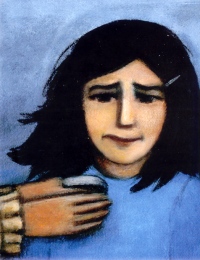| ________________
CM . . . . Volume XVIII Number 23 . . . . February 17, 2012
excerpt:
A sequel to the memoir Fatty Legs, A Stranger at Home details Margaret’s return to her Inuit family after being at residential school for two years. With endless chores and poor meals, the brothers and nuns had turned Olemaun, a plump, round-faced girl, into Margaret, a gaunt creature who had forgotten her mother tongue and was disgusted by her previously favourite foods. Margaret suffers the status of being an outsider; because of her lack of language, elders find her rude and younger children laugh at her. Books and dogs console her. Just when she’s finding happiness again, her father tells her she needs to go back to the residential school in order to take care of her younger sisters there. 
The level of detail makes this a very rich story. For example, the first time Margaret mentions her kamik, there is a footnote to inform readers that “Kamik are a type of soft boot worn by the Inuit. They are also called mukluks.” In the margin is a colour photograph of kamik. Some of the margin-notes are small photographs accompanied by page numbers directing the reader to larger, annotated photographs at the back of the book.
Highly Recommended. Shelbey Krahn is a teacher-librarian living in Sudbury, ON.
To comment
on this title or this review, send mail to cm@umanitoba.ca.
Copyright © the Manitoba Library Association. Reproduction for personal
use is permitted only if this copyright notice is maintained. Any
other reproduction is prohibited without permission.
NEXT REVIEW |
TABLE OF CONTENTS FOR THIS ISSUE
- February 17, 2012.
AUTHORS |
TITLES |
MEDIA REVIEWS |
PROFILES |
BACK ISSUES |
SEARCH |
CMARCHIVE |
HOME |
||||||
